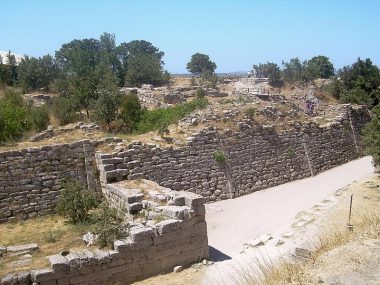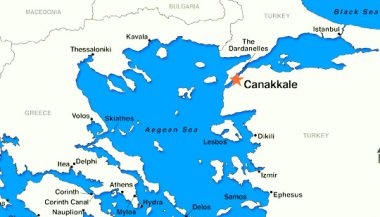Unlike other ancient ruins along Turkey’s Aegean coast, some of which are both imposing and intimidating, Troy appears the outcast, without imposing temples or remnant pillars soaring into the sky. Only a few walls remain of the legendary city. Visitors familiar with Homer’s epic Iliad will have a difficult time visualizing the long siege, centuries of silting having removed the cities remains from the Aegean. Perhaps the most realistic reminder of ancient Troy for modern minds sits in nearby Canakkale: the enormous horse used in the 2004 movie, donated by the films producers.
Troy in History
In the 1870s, Heinrich Schliemann, an adventurer and amateur archaeologist with a huge personal fortune, correctly deduced the location of the ancient city of Troy. Like many ancient sites of myth and legend, considerable doubt existed within academic communities that Troy had actually existed. During a series of excavations, Schliemann uncovered what he believed was the gold of Priam. Smuggled out of the country by Schliemann, some of the treasures he unearthed can be found in Moscow’s Pushkin Museum as well as the Archaeological Museum in Istanbul.
Homer’s tale of Troy spoke of a great city located at the approaches of the Dardanelles Strait. It was a highly strategic location for controlling trade passing between the Black Sea and the Aegean. Beyond the romance elements of the story, it is a tale of manipulation and conquest. Historically, the epic highlights the superiority of the Greeks and their favor with the gods. It is a story to explain the rise of Greek hegemony, just as many ancient myths present allegoric truths.
Excavations reveal thirty levels of existence as a community that began in the Bronze Age, circa 3000 BC. The second level, dubbed Troy II by archaeologists was destroyed by fire. This incarnation featured a prospering city and it was from this level that Schliemann removed precious artifacts he believed coincided with Homer’s Trojan War.



The city was rebuilt several times. Around 1200 BC, it was again destroyed, this time as a result of an earthquake. Some scholars believe that the events at this time more accurately fit the Homeric epic. Rebuilt again, the city was visited by an exuberant Alexander the Great in the Fourth Century who raced naked from the tomb of Achilles to Troy with his companions.
Alexander, who was told by his mother that he was a descendant of both Achilles and Hercules, carried with him Homer’s Iliad throughout his conquests; it was his favorite book. And the story of Troy’s destruction by the Greeks was an inspiration. As the city fell into distant memory, the Iliad kept its memory alive. Today, tourists walk the paths through the still on-going excavations and can only fantasize the scope of a once proud and grand ancient city.
Few places in the Aegean Sea evoke as many memories as Canakkale in western Turkey. Located on the Dardanelles south of Istanbul, the city hardly bears witness to the bloody World War One battle of Gallipoli, although the trenches are still there and can be visited by tourists interested in the battle that saved Constantinople in 1915. Canakkale is also the closest city to the fabled ruins of Troy. Today, the great Trojan Horse used in the 2004 Hollywood film stands proudly along the Canakkale waterfront, reminding visitors that the region played host to great ancient world conflicts, as well as a visit by Alexander the Great.
Canakkale and the Site of Ancient Troy
The Turkish government has limited resources to devote to the exploration and maintenance of ancient sites, including important ones like Troy. The ancient city, discovered by Heinrich Schliemann in the late 19th Century, is accessed through a gate adorned with a wooden horse, not nearly as imposing as the one on Cannakale’s waterfront. The ruins themselves hardly attest to the historical record: mere mounds and the remnants of walls.



The Cannakale Museum displays many of the artifacts recovered from the ruins, but the most prized antiquities were spirited out of the country by Schliemann and can only be seen in repositories like the Pushkin Museum in Moscow and the Hermitage in St. Petersburg, Russia.
The ruins of Troy hardly bear witness to the Hollywood films that depict the strategic city with intimidating walls, great temples, and the palatial living quarters of King Priam. Homer’s Iliad was a story that promoted Greek nationalism, at least from the perspective of Greek city-states attempting to curb the commercial influence of Troy, situated on a prosperous commercial sea route along the Dardanelles.
The Sounds of Modern Warfare Resonate in Festive Canakalle
During the night hours in Canakalle, the surrounding hills are lit-up, paying tribute to the 1915-1916 Battle of Gallipoli. Turkish forces stopped a desperate and determined allied offensive to destroy the defenses and ultimately take Constantinople. The Gallipoli defense was led by Kemal Ataturk, who founded the secular Turkish state after World War I.
Reminders of that bloody conflict still exist. Local travel companies book guided tours through the preserved trenches and Canakkale displays artillery pieces used during the campaign. Some of these are in the form of monuments along major thoroughfares of the city. Shops in the hotel district sell artifacts from the conflict: visitors can purchase everything from military insignia to replica medals.
Canakkale is the Gateway to Aegean Turkey
Canakkale is the logical place to stop for a day or two before proceeding south to the other great ancient sites of western Turkey. From here, visitors drive south to Pergamum, Ephesus, and Miletus, ending, perhaps, at Antalya. Yet it is fitting that the journey begins at Troy.
From Troy, Alexander marched against the Persians, inspired by his ancestor Achilles. Canakkale is the bridge between Istanbul, a city of millions, and the less cosmopolitan south, identified with an almost ageless ancient history that has witnessed the rise and fall of prosperous and significant civilizations.
